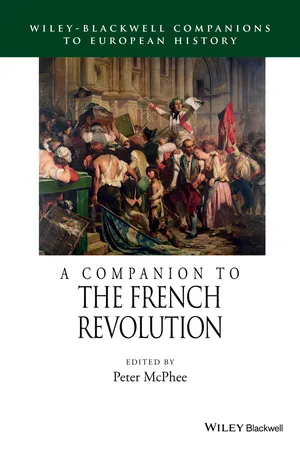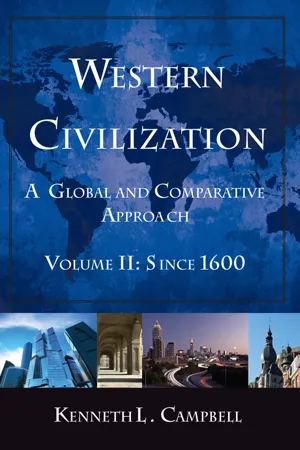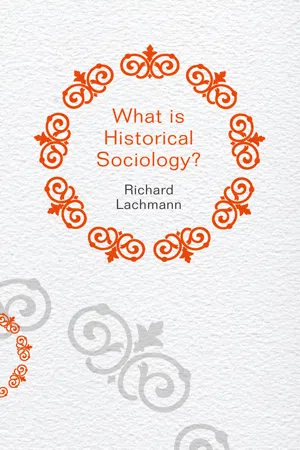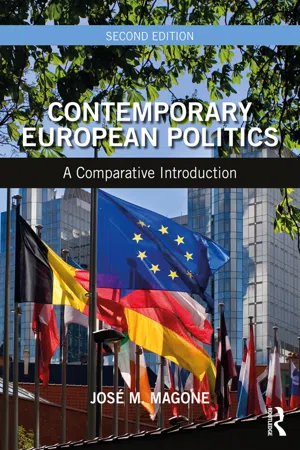History
European Revolutions
The European Revolutions refer to a series of political upheavals that took place across Europe in the 19th century. These revolutions were characterized by widespread social and political unrest, with the aim of challenging existing power structures and promoting liberal and nationalist ideals. While some of these revolutions resulted in short-term changes, they ultimately contributed to the broader transformation of European society and politics.
Written by Perlego with AI-assistance
Related key terms
9 Key excerpts on "European Revolutions"
- No longer available |Learn more
- John R. Barber(Author)
- 2011(Publication Date)
- Collins Reference(Publisher)
Ancien government and society had survived. The revolts, on the contrary, had ensured the eventual completion of sociopolitical modernization. Since the 1400s, all European states had modernized, in part through the secularization of social institutions, the development of professional government bureaucracies, and the establishment of standing armies under the control of the central executive. By 1848, Britain and France were fully modern, which meant that each had the following characteristics: consolidated territories, middle-class or joint bourgeois-aristocratic leadership; a government committed to industrialization; and an adequately large minority of the working populace mobilized in support of the state.The revolts of 1848 at once brought the bourgeoisie of Germany and Austria into a ruling partnership with the old elites, induced governments of the region to adopt the middle-class policy of industrial development, and accelerated the movement toward German and Italian unification. Germany and Italy would complete political modernization in the early 1870s. Although several European countries at that time still did not have all the traits of a modern sociopolitical system, the transformation had proceeded far enough so as to conclude that the new form of state had become typical of the region.Violent revolts against European governments have occurred rarely in the Modern era. When such events have taken place, they usually have broken out within a single country. The history of the years from 1815 to 1848 contrasts sharply with these typical patterns and marks this as an age of European revolution. Rebellion became both frequent and widespread, especially in 1830 and 1848.Revolutionaries in this era came from varied social backgrounds, but most were middle-class businesspeople and professionals. In keeping with bourgeois liberal ideals, they fought for self-government and personal liberty, demanding above all freedom to express their opinions and pursue business interests. In regions that lacked unity, such as Germany and Italy, revolutionaries also struggled to organize nation-states. - eBook - ePub
- Professor Jeremy Black, Jeremy Black(Authors)
- 2013(Publication Date)
- Routledge(Publisher)
9 THE TRANSFORMATION OF THE EUROPEAN WORLD, 1775–1830DOI: 10.4324/9781315012896-9The revolutions that shook the European world from 1775 were of critical importance both in changing that world and in altering its relationship with non-European peoples. It is too easy to treat the two as in some fashion different, and to argue, in particular, that shifts in the power distribution within the European world did not alter its essentially exploitative relationship with the rest of the world and did not change the fundamental lineaments of capitalist economics, Christian and white supremacism, and imperialism by a multipolar state system (as opposed to a single empire). While the latter are all true, it was, nevertheless, the case that changes within the European system were important to the wider global position of this system.The rise of the British empire
This chapter is concerned not with the struggle within Europe between the European powers, but rather with the position outside Europe, specifically the transformation of the colonial systems that focused on the loss of the American empires. Nevertheless, the struggle within Europe was important, for it helped to ensure that Britain, not France, became the leading European imperial state. This was crucial for the political culture that was to develop under imperial control. French-dominated colonies looked to Catholicism, civil law, French culture and language, and a different notion of representative government and politics to their British counterparts. The struggle between the European powers was central to the rise of the West, and to the question ‘Which West?’This was a struggle that was largely settled within Europe. Although it was very important that French colonies, and those of her allies, were captured by the British, this would have meant relatively little if Britain had succumbed to invasion, while, even if that had not occurred, a failure on the European continent of Britain’s forces and alliance system could ensure that gains made overseas had to be returned. Thus, in the Peace of Aix-la-Chapelle of 1748 that ended the War of the Austrian Succession, the British returned Louisbourg, conquered in 1745, because the French had succeeded in overrunning the Austrian Netherlands (modern Belgium) and invading the United Provinces (modern Netherlands). Similarly, in the Peace of Amiens of 1802 the British returned most of their colonial gains at the close of an unsuccessful conflict with Revolutionary France. In contrast, Napoleon’s defeat on the European continent in 1814 and 1815 enabled Britain to keep those of its colonial conquests it wished to retain. - eBook - ePub
The History of Democracy
A Marxist Interpretation
- Brian S. Roper(Author)
- 2012(Publication Date)
- Pluto Press(Publisher)
7
The revolutions of 1848–49 INTRODUCTIONIn 1848 the wave of revolutionary upheavals that swept across Western and Central Europe combined ‘the greatest promise, the widest scope, and the most immediate initial success, with the most unqualified and rapid failure’ (Hobsbawm, 1975: 37). But if these revolutions failed to achieve the creation of lasting republican democracies loosely modelled on those of the French and American revolutions, nonetheless they profoundly shaped the future course of European history, demolishing what remained of serfdom in Western and Central Europe, forcing monarchs to make liberal concessions that resulted in the prevalence and persistence of parliamentary forms of governance in which property owners were more widely represented than before 1848, and leading to the creation of constitutional, juridical and political arrangements that were significantly more favourable to the development of capitalism.This chapter outlines the wider historical context and underlying causes of the 1848 revolutions, provides a brief descriptive overview of the main events in France, Germany, Austro-Hungary and Italy, considers the June insurrection of workers in Paris, describes the conservative counter-revolution that destroyed the new governments created during the initial phase of the revolutions, and finally identifies the common features and historical legacy of these revolutions.BACKGROUND AND CAUSESThe revolutions of 1848 took place in the wider historical context of the transition from feudalism to capitalism, uneven development of capitalism across Europe, the rapid growth of industrial capitalism in Britain that provided the economic underpinning for the global expansion of the British Empire, and finally the growing pressure on France and Germany to introduce capitalist relationships in agricultural production and to industrialise in order to be able to compete with Britain’s growing economic and military power. Much of this has been discussed earlier. Nonetheless, it is important to recognise that the persistence of serfdom and feudal relationships in Central and Eastern Europe was a major cause of discontent among serfs and peasants, and was viewed as increasingly anachronistic by the bourgeoisie, state officials and enlightened members of the nobility. In this context maintaining the extraction of surplus product from peasants and workers as feudalism declined and capitalism developed was a major challenge for the landowning nobility and emerging bourgeoisie (Mooers, 1991: 27–40). - eBook - ePub
- Peter McPhee, Peter McPhee(Authors)
- 2012(Publication Date)
- Wiley-Blackwell(Publisher)
The “linguistic turn,” which emphasizes the Revolution as a transformation in political culture, has reinvigorated the Atlantic thesis, since historians have looked again at the connections and common features amongst the revolutions in the Atlantic world. Pre-eminent among these is Jourdan (2004), whose study of the American, Dutch, and French revolutions underscores their essentially “republican” frames of political reference, the similarities in political mobilization, and the fears and aspirations of the revolutionaries. Where they differed was in the extent of violence, change, resistance, and circumstances. A recent explosion in interest in the Haitian Revolution of 1791 has demonstrated that the Atlantic revolution also enveloped the Caribbean and the African diaspora. Extending the chronology beyond 1800 allows historians to include the Latin American wars of independence (Klooster 2009). So what, if anything, was exceptional about the French Revolution?Recent work on global history has also suggested that the French Revolution was merely one of many eruptions which amounted to a critical phase in the emergence of the modern world (Armitage and Subrahmanyam 2010). For Bayly (2004: 86–120), the epoch between 1780 and 1820 saw “converging revolutions,” transformations arising in different societies which would eventually transform the global order. Darwin (2007: 160) suggests that a “Eurasian revolution” arose from a series of crises which erupted in South Asia and Europe (and North America), tipping the global equilibrium in Europe’s favor. France was merely one epicenter among many, perhaps not even the most significant. If Atlantic interpretations once pushed the French Revolution into the water, the global perspective might well come along and steal its clothes. It is hard to deny that the collapse of the Mughal Empire in India, the transitions in the Ottoman Empire, as well as the revolutions in America, Haiti, and Latin America had global repercussions. Yet what distinguished the French Revolution individually - eBook - ePub
- Mehran Kamrava(Author)
- 2012(Publication Date)
- Routledge(Publisher)
6 RevolutionsThe appearance of revolutions and revolutionary movements in developing countries is a result of political as well as social and cultural developments and dynamics. More specifically, as discussed in previous chapters, the particular characteristics of Third World states, the larger consequences of social change, and the features inherent in political cultures combine to give rise to conditions conducive to the outbreak of revolutions. Nevertheless, despite the widespread prevalence of such conditions throughout the developing world, revolutions are rather rare historical occurrences. Why, it is thus important to ask, have revolutions not taken place with greater frequency given the existence of their social and political preconditions? Moreover, exactly how and what social and political dynamics lead to revolutions and at which specific junctures?Broadly, revolutions denote fundamental objective and subjective changes (i.e. both institutionally and culturally) in political arrangements and leaders, principles and orientations.1 They entail the transformation of the very political fabric on which a government is based. Palace coups and changes in leadership and in personalities do not necessarily constitute a ‘revolution’ in the fullest sense, despite what the coups’ protagonists often like to think. Nevertheless, it is quite conceivable that a coup may set in motion a chain of events which may lead to the outbreak of a revolutionary situation. Compared with military coups, revolutions entail much deeper and more profound changes. They turn the world of politics around, change the basic premises on which political culture is based and transform the larger implicit and explicit guidelines according to which political conduct is governed. In this respect revolutions are distinctively political episodes, although their precise occurrence is brought on by a coalescence of not only political but also social and cultural factors.2 As past and recent experiences have demonstrated, to say that revolutions are ‘political struggles of great intensity’3 and that they invariably involve considerable violence4 has become somewhat of a truism, although the decade of the 1980s did bear witness to the budding of ‘negotiated revolutions’ in some parts of Eastern Europe.5 Yet, by and large, revolutions still remain mass-based affairs of great magnitude, brought on and carried through by the mobilisation of masses of people against specific political targets. Even Hungary’s largely ‘negotiated revolution’ was precipitated and in turn fuelled by frequent and noisy protests by thousands of Hungarians in Budapest and elsewhere.6 - eBook - ePub
Western Civilization: A Global and Comparative Approach
Volume II: Since 1600
- Kenneth L. Campbell(Author)
- 2015(Publication Date)
- Routledge(Publisher)
The legacy of the French Revolution, the ongoing conflict between supporters and opponents of the revolutionary tradition, the forces of the Industrial Revolution, and the intellectual ferment that saw the rise of several new ideologies all culminated in a wave of revolution that swept across Europe in 1848. These were not the first revolutions of the post-Napoleonic period; the first wave of revolutions occurred in 1820 and included Spain, Portugal, and Italy. The Greek war for independence against the Ottoman Empire that began in 1821 was both a nationalist uprising against foreign rule and part of the same revolutionary wave of the post-Napoleonic period. Although repressive regimes across the continent crushed these revolutions (with the exception of the Greeks, who won their independence from the Ottomans in 1829), the revolutionaries and secret societies of this period sowed the seeds for future revolutions through the influence they had on young men such as Giuseppe Mazzini (1805–1872), a key Italian revolutionary in 1848.The next phase of revolution occurred in 1830 and included revolutions in France, Belgium, and Switzerland. In France, Charles X (r. 1824–1830) provoked widespread opposition with his July Ordinances of 1830, suspending freedom of the press, dissolving the newly elected Chamber of Deputies, placing further restrictions on the right to vote and the number of deputies in the chamber, and postponing new elections until September. Liberals regarded this as a blatant attempt to overthrow the constitution and to restore absolute authority to the crown. Almost immediately, revolutionaries threw up barricades in the streets of Paris. By July 30 Charles had rescinded the ordinances; on August 9 he abdicated his throne, saying he would rather be a woodcutter than a constitutional monarch such as the king of England. The French revolution of 1830 was thus spectacularly successful, resulting in the replacement of Charles by a cousin, Louis Philippe, who styled himself “King of the French.” In the same year, Belgium gained its independence and many Swiss cantons gained liberal constitutions as a result of their respective revolutions. - eBook - ePub
- Richard Lachmann(Author)
- 2013(Publication Date)
- Polity(Publisher)
The wave of anti-colonial movements that won independence for most of the Third World in the decades immediately following World War II challenged the ways in which academic disciplines, including sociology, thought about and studied the non-Western world. The notion that Western scholars had biases that shaped (or distorted) their understandings and theories became integral to much work done in and about the global South. Some Western academics joined their Third World counterparts in acknowledging that such cultural biases and blind spots affected their work on their own countries as well. In recent decades, area studies programs have become centers for scholarship that is much more critical of Western imperialism and that challenges Western intellectual hegemony (although some have cashed in on the “War on Terror” funding bonanza to offer advice once again to the US military on how to be more effective at counter-insurgency). Today, area studies scholars raise pointed questions about whether theories developed to explain Western revolutions and social movements are useful for understanding Third World politics. I will try to address those concerns in this chapter by specifying the extent to which explanations of revolutions or social movements in one part of the world can be generalized.Revolutions: Defining and Timing
Numerous scholars have offered a variety of definitions of revolutions.6 As Goodwin (2001, pp. 8–9) reminds us, “Concepts as such are not more or less true, but more or less useful for generating falsifiable explanations of interesting phenomena.” Nevertheless, when it comes time to list examples of revolutions and to specify the consequences of those revolutions, scholars’ lists and hierarchies are remarkably similar. Theda Skocpol, whose book States and Social Revolutions (1979) is the most influential sociological analysis of revolutions yet written, sums it up best when she distinguishes among “social revolutions,” which combine “the coincidence of societal structural change with class upheaval; and the coincidence of political with social transformation,” from “political revolutions,” which “transform state structures but not social structures, and … are not necessarily accomplished through class conflict,” and rebellions, in which subordinate classes revolt, but “even when successful … do not eventuate in structural change” (p. 4).All three of Skocpol's categories occur in relatively short time spans, a few years at most. Social movements, in contrast, can last for many years and, especially in the cultural realm, can affect social structure gradually. Yet, even such movements have their greatest impacts in much more concentrated periods of time, and, as we will see, the dynamic of social movements and the ways in which they interact with power holders is very different in moments where they are most consequential than during the long grinding years of relatively uneventful mobilization. - eBook - ePub
Europe's Uncertain Path 1814-1914
State Formation and Civil Society
- R. S. Alexander(Author)
- 2011(Publication Date)
- Wiley-Blackwell(Publisher)
2Political Contestation from the Vienna Settlement to the 1830 Revolutions, 1814–1832Dissatisfaction grew throughout the period of 1814–32. Calls for change resulted partly from the spread of liberalism, which in turn was tied to concerns about the relation between society and politics. Government was a means by which privilege was conferred and opposition to social or cultural (essentially religious) privilege could rapidly transform into demand for expansion of political rights or calls for reduction in the size of the state. Reformers frequently exaggerated the benefits that would result from alteration of a regime, and conservatives just as often overstated the harm that would occur. In consequence political change became fiercely contested. Prior to its arrival change generated excessive fear and after its establishment it produced disappointment when it failed to fulfill expectations.In his study of the period the historian Michael Broers has identified five main political groups – reactionaries, conservatives, liberals, radicals, and nationalists. Such categories are necessarily based on broad generalization and they seldom perfectly describe any individual. Individuals change and at a given time they often combine elements of differing belief systems. Nevertheless the categories do provide a useful means to begin discussion of the emerging ideologies.15In addition to wanting to erase the impact of the Revolution and Napoleon, reactionaries wanted to reverse the changes made to the ancien régime by the enlightened despots of the eighteenth century. Writers such as Louis de Bonald, a political and socialist theorist who had emigrated from France during the Revolution, rejected liberal emphasis on individual rights and argued that the society of orders was divinely inspired. Thus reactionaries rejected the concepts of national sovereignty and social equality, and often advocated close ties between Church and State, seeing both as bulwarks of social hierarchy. The complement to the latter was patriarchy and hence French reactionaries pushed for, and secured, abolition of divorce in 1816, a measure designed to restore “order” in the family and a rejection of Revolutionary secularism. Reactionaries frequently championed Church control over education so that the young would not be “infected” by liberal or democratic beliefs, and they fought tooth and nail against secular education systems. In their idealized vision of the ancien régime - eBook - ePub
Contemporary European Politics
A Comparative Introduction
- José M. Magone(Author)
- 2019(Publication Date)
- Routledge(Publisher)
In the eastern Balkans, Bulgaria and Romania were also influenced by the revolutions of 1848. Nationalist movements began to emerge at the end of the eighteenth century and continued throughout the nineteenth century. They led to national independence in Romania in 1859 and Bulgaria in 1878. In both cases, as already mentioned, Western European liberal constitutions, which closely followed that of Belgium in 1831, were adopted. In both countries, the British model of a two-party system of conservatives and liberals was established, but it soon degenerated into systemic corruption, alternating with periods of authoritarian rule. After the First World War, Romania was able to gain on territory in the Treaty of Versailles on 28 June 1919, while Bulgaria, which had joined the Central Powers, suffered a reduction of territory in the conference at Neuilly on 27 November 1919.In conclusion, 1848 has directly or indirectly been a major juncture of European politics. The revolutions and social movements emerging before, during and after 1848 led to the expansion of universal suffrage and the establishment of a model of liberal democracy that was interpreted in each country in a different manner.Industrialisation, the proletariat and the social questionThe democratisation process was intrinsically linked to the industrial revolution, which was not just a point in time but a process that lasted for more than a century. The industrial revolution transformed European semi-feudal societies into modern dynamic ones. The economic historian Karl Polanyi (1944) called it the ‘great transformation’. It emerged from the use of new technologies, for example the spinning wheel, steam engines applied to trains and ships, the blast furnaces in the steel industry, the railway and the telegraph. This was accompanied by new administrative management routines leading to predictability, reliability and rule of law (Finer, 1949: 710; Silberman, 1993).Industrialisation led to a more complex society based on the market economy. It had a major impact on society due to the mass migration of rural workers to the cities. A detailed report by Friedrich Engels in 1844 of the working conditions of workers in England gave rise to the term ‘Manchester capitalism’, named after the city that was the centre of the textile industry in the UK. Among the negative aspects of ‘Manchester capitalism’ were unregulated labour leading to accidents, the exploitation of child labour in the textile industry, and both women and men having to work more than twelve hours a day. In addition, there was a ‘truck system’ set up by employers that allowed further exploitation of workers. This system provided workers with accommodation in overcrowded places and with the basic articles for survival through the employer’s shop, with a consequence of debt dependency. Over time, workers accumulated debts that they were unable to repay within their lifetime. They became more or less slaves of the factory system (Engels, 1974). This was one of the conditions for the establishment of a rich bourgeoisie, who could make large profits from their various enterprises. Early industrialisation in Britain created a first national mass market, something that was emulated in other countries (Ferguson, 2007; Hobsbawn, 1984).
Index pages curate the most relevant extracts from our library of academic textbooks. They’ve been created using an in-house natural language model (NLM), each adding context and meaning to key research topics.








